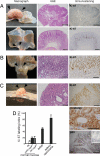Transgenic expression of Helicobacter pylori CagA induces gastrointestinal and hematopoietic neoplasms in mouse
- PMID: 18192401
- PMCID: PMC2242726
- DOI: 10.1073/pnas.0711183105
Transgenic expression of Helicobacter pylori CagA induces gastrointestinal and hematopoietic neoplasms in mouse
Abstract
Infection with cagA-positive Helicobacter pylori is associated with gastric adenocarcinoma and gastric mucosa-associated lymphoid tissue (MALT) lymphoma of B cell origin. The cagA-encoded CagA protein is delivered into gastric epithelial cells via the bacterial type IV secretion system and, upon tyrosine phosphorylation by Src family kinases, specifically binds to and aberrantly activates SHP-2 tyrosine phosphatase, a bona fide oncoprotein in human malignancies. CagA also elicits junctional and polarity defects in epithelial cells by interacting with and inhibiting partitioning-defective 1 (PAR1)/microtubule affinity-regulating kinase (MARK) independently of CagA tyrosine phosphorylation. Despite these CagA activities that contribute to neoplastic transformation, a causal link between CagA and in vivo oncogenesis remains unknown. Here, we generated transgenic mice expressing wild-type or phosphorylation-resistant CagA throughout the body or predominantly in the stomach. Wild-type CagA transgenic mice showed gastric epithelial hyperplasia and some of the mice developed gastric polyps and adenocarcinomas of the stomach and small intestine. Systemic expression of wild-type CagA further induced leukocytosis with IL-3/GM-CSF hypersensitivity and some mice developed myeloid leukemias and B cell lymphomas, the hematological malignancies also caused by gain-of-function SHP-2 mutations. Such pathological abnormalities were not observed in transgenic mice expressing phosphorylation-resistant CagA. These results provide first direct evidence for the role of CagA as a bacterium-derived oncoprotein (bacterial oncoprotein) that acts in mammals and further indicate the importance of CagA tyrosine phosphorylation, which enables CagA to deregulate SHP-2, in the development of H. pylori-associated neoplasms.
Conflict of interest statement
The authors declare no conflict of interest.
Figures




References
-
- Parkin DM. Global cancer statistics in the year 2000. Lancet Oncol. 2001;2:533–543. - PubMed
-
- Peek RM, Jr, Blaser MJ. Helicobacter pylori and gastrointestinal tract adenocarcinomas. Nat Rev Cancer. 2002;2:28–37. - PubMed
-
- Parsonnet J, et al. Helicobacter pylori infection and gastric lymphoma. N Engl J Med. 1994;330:1267–1271. - PubMed
-
- Kuipers EJ, Perez-Perez GI, Meuwissen SG, Blaser MJ. Helicobacter pylori and atrophic gastritis: importance of the cagA status. J Natl Cancer Inst. 1995;87:1777–1780. - PubMed
-
- Sozzi M, et al. Atrophic gastritis and intestinal metaplasia in Helicobacter pylori infection: the role of CagA status. Am J Gastroenterol. 1998;93:375–379. - PubMed
Publication types
MeSH terms
Substances
LinkOut - more resources
Full Text Sources
Other Literature Sources
Molecular Biology Databases
Miscellaneous

